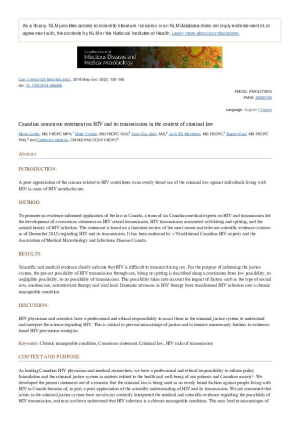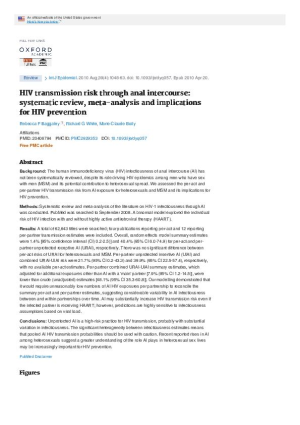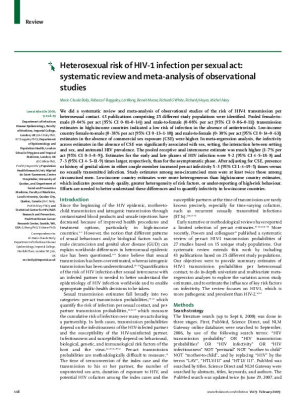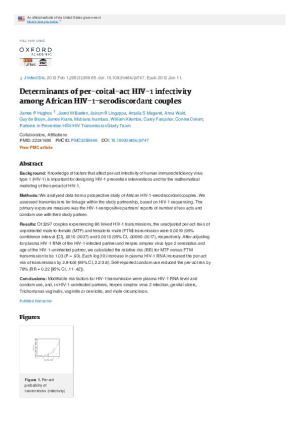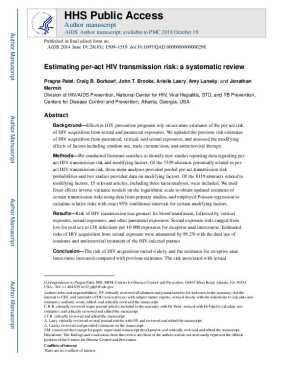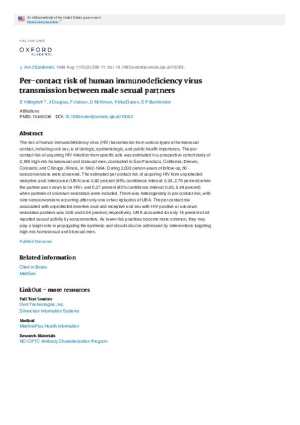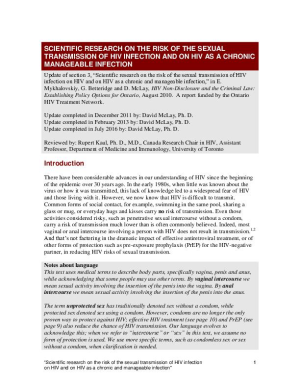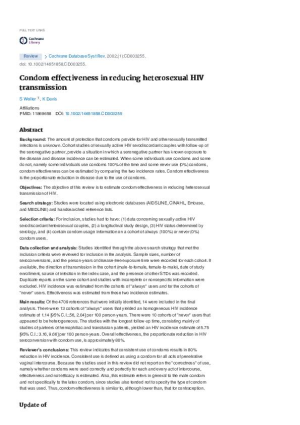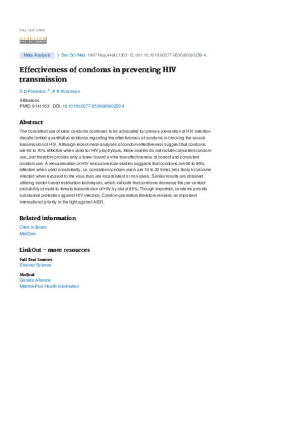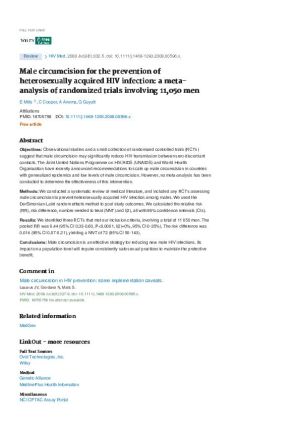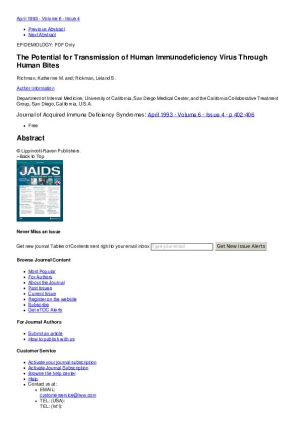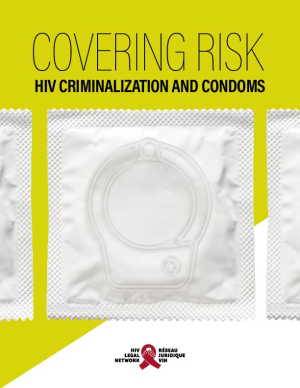Provides current scientific evidence to facilitate just outcomes in Australian criminal cases involving HIV. Argues that careful attention should be paid to the best scientific evidence on HIV risk and harms, with consideration of alternatives to prosecution, including public health management. Authored by leading Australian HIV clinicians and scientists.
Scientific evidence in a legal context
HIV transmission modes and risks
Canadian Consensus Statement on HIV and its transmission in the context of the criminal law
Sets out in clear, concise, and understandable terms a collective expert opinion about HIV sexual transmission, transmission associated with biting and spitting, and HIV as a chronic manageable condition. Authored by six distinguished Canadian HIV clinicians and scientists.
- Alternative links
- French
Transmission Routes, Viral Loads and Relative Risks: The Science of HIV for Lawyers and Advocates
This document from the Center for HIV Law and Policy, published in 2011, lists articles on a range of background issues relevant to HIV criminalisation (particularly in the U.S.) including HIV as a chronic condition, coverage under the ADAAA, transmission routes and risk, viral load and treatment, and phylogenetic analysis.
HIV transmission risk through anal intercourse: systematic review, meta-analysis and implications for HIV preventions
Reports findings from systematic review and meta-analysis of the literature on HIV-1 infectiousness through anal intercourse.
Heterosexual risk of HIV-1 infection per sexual act: systematic review and meta-analysis of observational studies
Reports findings from systematic review and meta-analysis of observational studies of the risk of HIV-1 transmission per heterosexual contact (43 publications based on 25 studies).
Determinants of Per-Coital-Act HIV-1 Infectivity Among African HIV-1–Serodiscordant Couples
Reports data from a prospective study of African HIV-1–serodiscordant couples assessing transmissions for linkage within the study partnership, based on HIV-1 sequencing. Modifiable risk factors were (HIV-positive partner) RNA level and condom use, and (HIV-negative partner) presence of STIs and male circumcision.
Per-contact probability of HIV transmission in homosexual men in Sydney in the era of HAART
Reports data from a longitudinal cohort study of community-based HIV-negative homosexual men in Sydney, Australia. Reports risk of infection through unprotected anal intercourse.
Estimating per-act HIV transmission risk: a systematic review
Reports analysis of recent studies on per-act HIV transmission risk and modifying factors. Includes risk associated with blood transfusion, vertical exposure, sexual exposures, and parenteral exposures. Finds the risk of HIV acquisition varied widely, with risk from sexual transmission substantially reduced by combined use of condoms and antiretroviral treatment of HIV-infected partners.
Per-contact risk of human immunodeficiency virus transmission between male sexual partners
Reports on follow up from prospective cohort study of gay and bisexual men. Findings include estimates of risk from unprotected anal intercourse and oral sex.
Scientific research on the risk of the sexual transmission of HIV infection and on HIV as a chronic manageable infection
Explains HIV transmission risk with reference to numerous studies, including a chart summarising per-act risk estimates for transmission of HIV during different types of sexual intercourse.
(update of original chapter in E. Mykhalovskiy, G. Betteridge and D. McLay, HIV Non-Disclosure and the Criminal Law: Establishing Policy Options for Ontario)
Routes, Risks and Realities of HIV Transmission and Care: Current Scientific Knowledge and Medical Treatment
This factsheet from the Center for HIV & Law Policy, published in 2017, outlines HIV transmission risk (based on “HIV Medicine and Science: Transmission Considerations”).
- Alternative links
- Spanish / Español
Condom effectiveness in reducing heterosexual HIV transmission
Review of 14 rigorous studies to re-estimate condom effectiveness in reducing heterosexual transmission of HIV. Finds consistent condoms use results in an 80% reduction in HIV incidence, i.e 80% less than the particular act without condoms. Consistent use is defined as using a condom for all acts of penetrative vaginal intercourse.
Effectiveness of condoms in preventing HIV transmission
Recent meta-analyses of condom effectiveness suggest that condoms are 60 to 70% effective when used for HIV prophylaxis. A re-examination of HIV seroconversion studies suggests that condoms are 90 to 95% effective when used consistently, i.e. consistent condom users are 10 to 20 times less likely to become infected when exposed to the virus than are inconsistent or non-users. Similar results are obtained utilizing model-based estimation techniques, which indicate that condoms decrease the per-contact probability of male-to-female transmission of HIV by about 95%.
Male circumcision for the prevention of heterosexually acquired HIV infection: a meta-analysis of randomized trials involving 11 050 men
Systemic review of medical literature found male circumcision is an effective strategy for reducing new male HIV infections, however, its impact at population level requires consistently safe sexual practices to maintain the protective benefit.
The potential for transmission of human immunodeficiency virus through human bites
Reviews evidence related to the potential for HIV transmission through human bites. Concludes that while biologically possible, transmission remains unlikely, risk is epidemiologically insignificant and as yet, has not been well documented.
Spit Does Not Transmit: A Fact Sheet for Law Enforcement Personnel, The Center for HIV Law and Policy, the National Organization of Black Law Enforcement Executives and the Association of Prosecuting Attorneys (2013)
This 2013 factsheet produced by the Center for HIV Law and Policy, the National Organization of Black Law Enforcement Executives and the Association of Prosecuting Attorneys provides current factual information about the HIV transmission risks law enforcement professionals may face in the line of duty (aiming to address the frequent overstating of risk). States there is no known case of a law enforcement officer being infected in the line of duty through spitting or biting.
Lack of transmission of HIV through human bites and scratches
Report of small study following an HIV-positive man with severe brain damage and poor dental hygiene (causing bleeding gums) who was frequently violent to hospital staff. After 2.5 years follow up, all of the 30 people he’d bitten or scratched remained HIV-negative.
Risk of HIV Infection Per Single Sexual Exposure to an Individual Living with HIV, and Other Life Events Comparable Risk of Occurrence
Compares risk of HIV transmission from a single sexual encounter with odds of illness or death from other life events.
A systematic review of risk of HIV transmission through biting or spitting: implications for policy
A systematic literature search was conducted using Medline, Embase and Northern Lights databases and conference websites. Results showed that there was no risk of transmitting HIV through spitting, and the risk through biting was negligible. Post‐exposure prophylaxis was not indicated after a bite in all but exceptional circumstances. Policies to protect emergency workers should be developed with this evidence in mind.
- Alternative links
- Español (Traducción automática), Français (Traduction automatisée)
Covering Risk: HIV Criminalization and Condoms
While some policymakers and courts have recognized condom use as sufficient to negate possibility of HIV transmission, people living with HIV in Canada remain at risk of prosecution for alleged non-disclosure before sex with a condom. While the law may be unsettled, the science and policy reasons are clear: prosecuting people living with HIV who use condoms is unscientific and unfair. Law- and policymakers must act to definitively preclude prosecutions against people living with HIV who use condoms.
Expert consensus statement on the science of HIV in the context of criminal law
Twenty scientists from regions across the world developed this Expert Consensus Statement to address the use of HIV science by the criminal justice system. Description of the possibility of HIV transmission was limited to acts most often at issue in criminal cases. The authors recommend that caution be exercised when considering prosecution, and encourage governments and those working in legal and judicial systems to pay close attention to the significant advances in HIV science that have occurred over the last three decades to ensure current scientific knowledge informs application of the law in cases related to HIV.
- Alternative links
- Czech: Expertní prohlášení k vědeckým poznatkům o HIV v kontextu trestního práva , French: Déclaration de consensus d'experts sur la connaissance scientifique relative au VIH dans le contexte du droit pénal, German: Expertenkonsens zur HIV-Wissenschaft im Kontext des Strafrechts, Mandarin: 專家共識聲明:刑法脈絡下的愛滋相關科學, Russian: Заявление об экспертном консенсусе в отношении научных данных о ВИЧ- инфекции в контексте уголовного права , Spanish: Declaración de Consenso de expertos sobre la ciencia relativa al VIH en el contexto del derecho penal
The Expert Consensus Statement on the Science of HIV in the Context of Criminal Law – Five-year Impact Report: Bringing Science to Justice
In 2018, twenty leading HIV scientists published the ‘Expert Consensus Statement on the Science of HIV in the Context of Criminal Law’ (Expert Consensus Statement) to address the misuse of HIV science in punitive laws and prosecutions against people living with HIV for acts related to sexual activity, biting or spitting. The process involved undertaking detailed analysis of the best available scientific and medical research data on HIV transmission, treatment effectiveness and forensics. Building on an initial scoping report published in 2020, the HIV Justice Network (HJN) undertook further research between April and July 2023 examining the impact of the Expert Consensus Statement in cases and advocacy in the five years since its publication.


